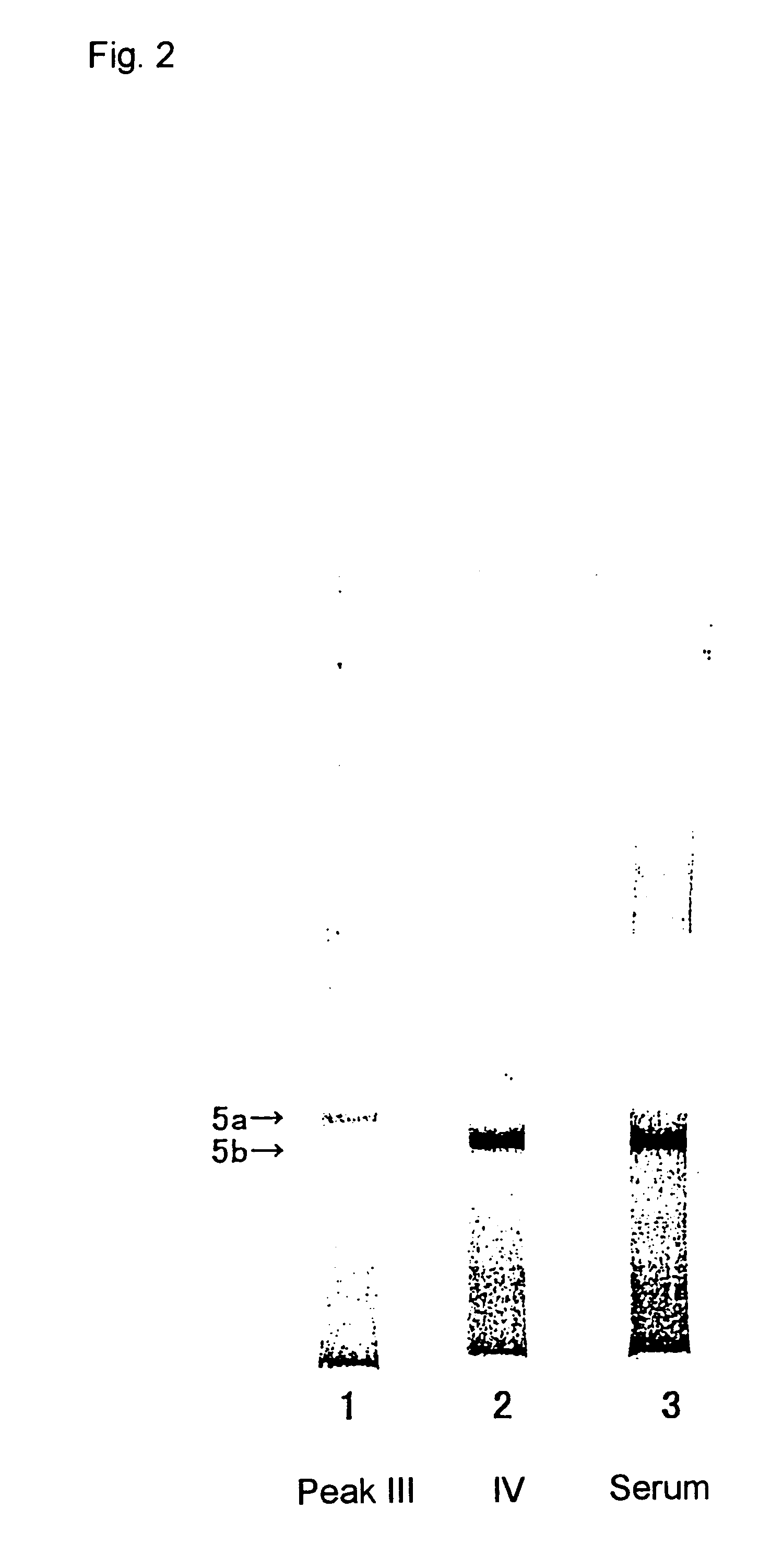Method for specific measurement of acid phosphatase derived from osteoclasts
a specific measurement and acid phosphatase technology, applied in the field of specific measurement of acid phosphatase derived from osteoclasts, can solve the problems of complex measurement and measurement time, specificity, sensitivity, and inability to differentiate acid phosphatase, and achieve the effect of simple, economical and clinically availabl
- Summary
- Abstract
- Description
- Claims
- Application Information
AI Technical Summary
Benefits of technology
Problems solved by technology
Method used
Image
Examples
example 1
Separation of Band 5a and Band 5b tartrate-resistant acid phosphatase by cation exchange chromatography
Using CM-Sepharose, Band 5a and Band 5b tartrate-resistant acid phosphatase were separated and collected.
The CM-Sepharose was packed into glass tubing (0.9 cm i.d.; length, 60 cm) and washed with acetate buffer (10 mmol / L, pH 5.0). The serum sample (children's serum, 5 ml) was adjusted to pH 5.0 by adding acetic acid and the coagulated proteins were removed by centrifugation at 20,000.times.g for 15 minutes. The supernatant fraction was passed through the column at 0.5 ml / minute. The enzyme, which was retained on the column, was then eluted with a liner gradient of sodium chloride: 0 to 1 mol / L in elution buffer (299 ml, acetate buffer, 10 mmol / L, pH 5.0). The fractionated serum was subjected to the method described in the above general method to measure tartrate-resistant fluoride-sensitive acid phosphatase activity (the value obtained by subtracting the value obtained with measur...
example 2
Effect of heparin on Band 5a and 5b tartrate-resistant acid phosphatase and bone extract
Band 5a and 5b tartrate-resistant acid phosphatases prepared in Example 1 were used.
Bone extract was prepared according to the method described in Nakanishi, M., Yoh, K., Uchida, K., Maruo, S., Matuoka, A., Clin. Chem., 1998, 44, 221-225. Bovine tibia after removal of soft tissue was cut into small cubes. The marrow and blood were removed, pulverized and homogenized in a solution containing Triton x-100, potassium chloride, phenylmethylsulfonyl fluoride, benzamidine and aminocaproic acid. The extract was collected by centrifugation at 10,000.times.g for 20 minutes at 4.degree. C. and stored at -80.degree. C. until use.
The effect of heparin on Band 5a and 5b tartrate-resistant acid phosphatases and bone extract is shown in FIG. 3. The effect of Band 5a tartrate-resistant acid phosphatase was significantly inhibited by heparin whereas the effects of Band 5b tartrate-resistant acid phosphatase was n...
example 3
Effect of pH on Band 5a and 5b tartrate-resistant acid phosphatase
Tartrate-resistant fluoride-sensitive acid phosphatase activity was measured using Band 5a and 5b tartrate-resistant acid phosphatases separated by CM-Sepharose to determine the effect of pH on activity.
Using 150 mM MES (2-morpholino-ethanesulfonic acid)(pH 5.0 to 6.4) buffer and 150 mM MOPOS (pH 6.6 to 7.2) buffer, to these buffers were added 60 mM L(+)-sodium tartrate, 0.5% bovine albumin and 0.05% heparin or 3% polybrene to carry out the measurement.
The result is shown in FIG. 4. The optimal reaction pH of Band 5a tartrate-resistant acid phosphatase (peak III) activity is approximately 5.8, while Band 5b tartrate-resistant acid phosphatase (peak IV) activity is 6.6. The addition of heparin in the reaction mixture reduced only Band 5a tartrate-resistant acid phosphatase activity to zero level at pH 6.6.
PUM
 Login to View More
Login to View More Abstract
Description
Claims
Application Information
 Login to View More
Login to View More - R&D
- Intellectual Property
- Life Sciences
- Materials
- Tech Scout
- Unparalleled Data Quality
- Higher Quality Content
- 60% Fewer Hallucinations
Browse by: Latest US Patents, China's latest patents, Technical Efficacy Thesaurus, Application Domain, Technology Topic, Popular Technical Reports.
© 2025 PatSnap. All rights reserved.Legal|Privacy policy|Modern Slavery Act Transparency Statement|Sitemap|About US| Contact US: help@patsnap.com



